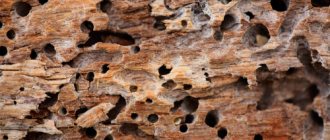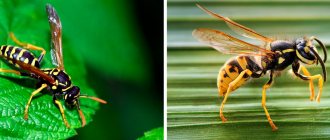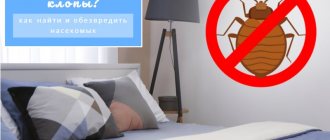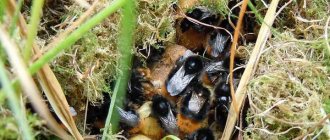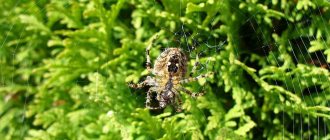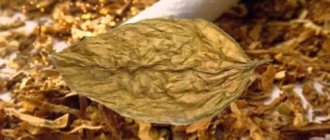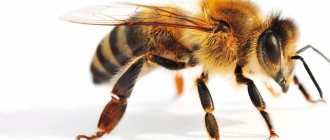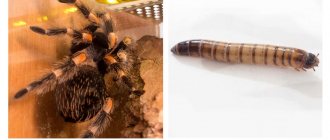How to find a wasp's nest
Finding insect habitats is not always easy. This is due to the fact that wasp hives can be located in a variety of places:
- underground in empty mouse holes;
- on branches and in the hollows of old trees;
- in basements and attics of residential premises.
Only a thorough inspection of the utility rooms located in the house and apartment will help you find a hive.
Wasps are in constant search of food for the larvae growing in their nest. The desire to feast on sugary substances attracts insects to people’s homes, especially during the period of making jam. They do not disdain meat scraps from human food.
If it is not possible to determine the presence of a nest visually, and the presence of insects bothers you, then you should leave fruit or pieces of meat in a visible place. By observing where the uninvited guests take their prey, it will most likely be possible to determine their permanent location.
The size of the constructed hive can range from the diameter of a tennis ball to a basketball, and in some cases larger. Regardless of the location, the wasp hive is built in the form of a horizontal structure, the cells of which face downward with their entrances.
Important! When trying to destroy a wasp's nest, do not stand directly under it, otherwise an angry swarm of wasps will fall right on the head of its offender.
If during the search a wasp nest was discovered in the initial stage of construction, then measures must be taken to eliminate it as quickly as possible. This is due to the very fast pace of work of the insect. Sometimes a new house grows right before the eyes of people amazed at the speed of its appearance.
Should we look for honey in a wasp's nest in our latitudes?
Anyone can notice that nimble yellow-black insects love to feast on sweets. Just open a jar of honey or jam - and they are right there. Wasps are circling over flowering meadows and over apple and linden trees. Do these predators hunt bees or collect nectar? Gardeners believe that wasps pollinate plants no worse than furry workers from hives. But, unfortunately, striped insects do not have not only the enzymes that allow pollen and nectar to turn into honey, but even a proboscis for collecting. Wasps are not averse to feasting on the sweet juice of flowers, but they do not store it in their nests and do not store it for the winter. But still there is something similar to honey in their honeycombs. This substance is called “spray”. This is a thin layer of honey, as minuscule as the amount of wax covering cooking paper.
Where do wasps nest?
The young queen chooses a place where there is building material and food supplies in close proximity. In the wild, insects make their homes on trees with a large, dense crown, under old stumps, and abandoned bird houses. However, there are cases of a hive being built under a stone, on a blade of grass. Where the young female considers it necessary to build housing, the working individuals will continue the construction.
Insects can build hives near humans - under the roof of a house, outbuildings, in an attic, on a balcony, or live in a garden, yard, vegetable garden, or vineyard. And also on trees, bushes, old stumps on the site. If in the wild, wasps bring a lot of benefits, destroying harmful insects, in the territory of a garden, summer cottage, yard, they become real pests. Therefore, a person tries to get rid of wasp nests on a balcony, in a country house, or in a vineyard.
On a note!
It's very easy to anger a wasp. A few sharp movements are enough for her to rush to attack. During an attack, it makes special sounds - signals, warns other members of society about the danger, and also calls for help. If there is a nest nearby, a whole swarm can attack a person.
What types of wasps are there?
Insects are divided into several families. The most common wasp species are:
- paper;
- floral;
- hornets;
- shiny;
- road;
- German;
- scolias;
- Typhia;
- riders.
Each insect has differences not only in body structure, but also in lifestyle, nutrition and toxicity of the poison.
Paper wasps
The most common subfamily of wasps in Russia is called paper wasps. 30 species of these insects live in temperate latitudes. Their appearance is familiar to everyone - a yellow-black body, a black head and short antennae. These wasps were called paper wasps because of the unusual structure of the nest. The walls of the hive are quite thin and resemble sheets of paper.
Insects unite in a large swarm. They build a nest in spring and summer. During the first month of summer, pests lay eggs. The diet of larvae differs from that of adults. The cubs feed on small insects that the swarm brings for them. Adult wasps only attack other species; they themselves do not eat protein foods. Insects drink nectar and juice from fruits.
The larva goes through several stages of development, including the period of pupation and adulthood. The whole process takes about 20 days. Therefore, most insects appear in sight in mid-summer.
Wasps protect their nest from possible dangers. A person who happens to be near the hive will be stung. If he does not leave the area, the entire swarm of wasps may arrive. In autumn, paper species leave the nest. Most individuals die before next spring. Young females spend the winter and continue the race with the onset of late spring.
Flower wasps
This type of insect belongs to the subfamily Foldoptera. Individuals are also called mazarins. Flower wasps settle alone and do not create a swarm.
The size of these insects is no more than 1 cm. Their black body is covered not with stripes, like paper wasps, but with yellow spots. Pests' feet are bright yellow.
Wasps feed on flower pollen and settle near a food source. To procreate, each female creates a nest, which consists of one cell. They build nests not only in trees, but also on the ground. Mazarins combine clay and sand with a special sticky secretion. After the wasp places the egg in the cell, it seals it with a sufficient amount of flower nectar.
Mazarins live for several years. They love hot climates. In Russia, the insect can be found in the southern part of the country.
Shiny wasps
Sparkles are distinguished by a relatively small body. The length of an adult is no more than 1.5 cm. Also, the color of these insects is not similar to other species. The black shell shimmers with a violet-green tint, reminiscent of a metal coating.
The body of shiny wasps has a concave shape. Due to this feature, pests can curl up into a ball when in danger. In some species, the sting has no function. Individuals scare away enemies with their bright colors. But there are also stinging species of shiny wasps.
This is interesting: A species of wasp called “beautiful shiners” parasitizes other insects. He lays eggs in the body of a spider that has been paralyzed by the pelopea. When the beautiful shiner larva hatches, it eats the pelopea and then the spider itself.
Males and females of this insect species differ in body structure. The abdomen of males consists of five segments. In females, one part changes to a tubular-shaped ovipositor.
Road wasps
The subfamily belongs to a single type. Road wasps are medium in size. They do not exceed 4 cm in length. The color of the insects is similar to the subfamily Foldoptera. The black shell is covered with yellow or red spots.
For more information about the type of wild black wasp, the danger to humans and methods of disposal, read this article.
This species of wasp has long hind legs. Each limb has a small appendage with which the insect can loosen the ground. Road species do not create nests in trees. They always choose burrows in the soil as their habitat. Wasps rarely fly and prefer to move on the ground.
Insect venom is very toxic. Their bite is quite painful. Road wasps are nicknamed killer wasps due to their aggressive nature. These are predatory insects that prey on arachnids. The road wasp can kill a tarantula with one blow of its poisonous sting. After the spider dies, the insect drags it into the hole and lays eggs in the body of the prey.
Hornet
Hornet
The largest genus of the paper wasp group are hornets. These are the largest representatives of wasps, growing up to 5.5 cm. They are found mainly in the northern hemisphere, considered a rare species. The hornet is a fairly large representative of wasps with extremely caustic poison. Hornet stings are painful and can lead to disastrous consequences for humans.
Black wasps
Black wasps
Black wasps are also sand wasps. They are medium or large. Extremely poisonous, they live in tropical countries. Sometimes found in northern regions.
White and red wasps
White and red wasps are also extremely poisonous. They can kill a person with one bite.
Sand wasps
Sand wasp with prey
Sand wasps, numbering over 8 thousand species. They can be small - up to 0.5 cm or large - up to 2 cm. The species can be found in tropical countries. These wasps are predatory and live underground, where they build nests. Mostly black and yellow in color.
Interesting fact : paper wasps living near humans live in swarms. They distinguish each relative by remembering their faces.
German wasps
The second name of this subfamily is velvet ants. These include more than 4 thousand species. They live in deserts and steppes. Male and female German wasps are very different from each other.
The male is larger than the female. The maximum size of a wasp is 3 cm. Males have wings. They can be either completely black or with red spots in the sternum area.
Female velvet ants do not have wings. It is because of this feature that they received their name. The body of insects is covered with hairs and resembles velvet fabric. The sternum is bright red. The top of the abdomen is black with yellow splashes, the bottom has black and yellow stripes.
A squad of velvet ants takes over other people's hives. Insects settle in the nests of bumblebees and road wasps. The larvae feed on the eggs of other species that are in the hive. After the young individual escapes from the cell, it feeds on flower nectar and insect corpses.
The venom of the German wasp is toxic. If it bites a person, a painful swelling will form.
Scolia
The insects are as large in size as hornets. Scolia can reach 6 cm in length. They thrive in tropical climates, but sometimes adapt to northern regions. Scolia have a black and yellow coloration, but the wings are different from other individuals. They have a light brown tint with a purple sheen.
Scolia poison is dangerous for humans only if there is individual intolerance. But the reaction to a bite can be frightening. From the toxin, the limb affected by the poison begins to go numb.
Unlike other species, the female Scolia is larger in size than the male. Insects feed on the nectar of flowers. Scolia's offspring are carnivorous. The venom of adults paralyzes the nervous system of the larvae. Scolia sting the victim in the abdomen, immobilizing it. They feed their offspring with rhinoceros beetle larvae and hunt bronze beetles and beetles. The wasp lays eggs in the body of an immobilized victim. After this, the larva hatches and devours it from the inside.
Typhia
The subfamily includes about 50 species of wasps. Their size varies from 0.5 to 1.3 cm. Most individuals are black. There are species of insects with ebony shells and thin yellow stripes. The limbs of males and females are different. The paws of males are brown, females are burgundy.
A distinctive feature of typhus is a unique defensive reaction. When attacked, the wasp curls up into a ball.
Insects live in places where there are many pest beetles. They feed on the sticky secretions of aphids. Typhias attach eggs to the shells of beetles and bread beetles. Over time, larvae emerge from them, which gnaw through the shell of the insect and feed on it. Typhia pupates inside the chitinous covering of the beetle. The young individual emerges from the cocoon only the next year.
Typhias are often found in gardens and orchards. They can be seen on umbrella plants. Thanks to this type of wasp, the population of pests that destroy crops is reduced.
Rider
This subfamily is distinguished by a more elongated body and small size. There are individuals 3 mm long. The largest reach 3 cm. Color depends on the species. Individuals can be either black or completely transparent.
The wings of the rider are shaped like the wings of a dragonfly. Some species of the subfamily do not fly and look like ants. The body of these pests differs from other species in having a more elongated abdomen, which resembles a long tail. It may seem that the ichneumon wasp is a wasp with a long stinger, but this is not entirely true. The appendage is the sharp tip of the ovipositor. This species has no sting.
The parasites lay eggs in the bodies of insects. Most often they use caterpillars. The secretion contained in the ovipositor has a paralyzing effect on the victim. These pests pierce the insect's skin and inject poison under the skin. Then the clutch is placed inside the victim.
Equestrians prefer tropical habitats. But several species can be found in temperate climates.
All types of wasps have not yet been studied. Subfamilies of these insects live in different parts of the globe and quickly adapt to new conditions. Wasp venom rarely poses a danger to humans. And since insects destroy parasites that multiply on vegetable, fruit and berry crops, they bring many benefits to the crop.
Construction material
The finished wasp nest is nothing short of impressive. From the outside it looks like a smooth, oval-shaped egg. Inside, numerous honeycombs are found, arranged in a certain way. The building material resembles ancient parchment. Mostly gray, brownish in color. Because of the way wasps build their nests, they are called paper wasps. The family is one of the most numerous and includes species and subspecies.
What wasps make nests from and how building materials are obtained also deserves respect. The insect lands on wood, spits out a certain amount of its own secretion, under the influence of which the upper tissues of the tree bark liquefy. The wasp grabs the top layer with its powerful jaws and pulls it towards itself, as if scraping it off. When she has the amount she needs, she goes to a place where other relatives are making a hive.
Having arrived at the right place, the wasp once again carefully chews the building material with its jaws. Under the influence of saliva, the wood becomes sticky, stringy, gray or brown, depending on what tree it was extracted from. The wasp spits the finished building material onto the already formed honeycombs, again stretches it with its jaws, giving its structure an oval shape. This is how a new thin partition appears.
Interesting!
The wasp obtains woody elements from the bark of various trees, stumps, fences, and wooden outbuildings. If there is not enough building material or the queen finds a place suitable for raising larvae, the wasps build a nest underground, in old stumps, hollows, left by bird houses.
What do wasps make their nests from?
Nature compensated for the inability to secrete wax by giving the wasps jaws. With their help, insects scrape pieces of rotten wood, and then glue the resulting mass with the liquid produced during chewing. Wood chips, bark and even sawdust are used. The construction material obtained in this way can be compared in appearance to wrapping paper. For this skill, the insects received the name “paper wasps.”
The walls of the internal cells have a denser and smoother structure. The layers of the outer sphere of the structure under construction look quite loose. Wasps that live in the tropics use everything they find to create their hives: limestone pieces, clay grains of sand, and, if necessary, manure.
There are several thousand species of wasps, each of which adapts to environmental conditions in its own way. Habitat features greatly influence what wasps use to make a hive.
What do wasps make their nests from?
The largest species of wasps, hornets, use young tree bark for construction. From the outside, a hornet hive looks like a large bucket, and in cross-section, the cells of the nest are colored yellow-brown, sandy or brown.
Construction process
A fertilized young female, the queen, chooses a place for her future home.
It glues an adhesive substance extracted from wood to the base, stretches it, and a leg is formed, on which the first honeycombs are subsequently built. Initially there are very few of them; they are necessary for growing and feeding the larvae. The process begins in early spring. Within a month, a new generation of worker wasps appears and begins active construction of the hive. The uterus sheds the powers of an architect and is engaged only in the reproduction of offspring.
- The hornet's nest is being built at an accelerated pace, since the number of members of the large family is rapidly increasing. New cells appear at the base of the handle, which overlap each other to form a honeycomb.
- As the number of cells increases, a bowl-shaped structure begins to emerge. Over time, it increases in depth, expands on all sides, and becomes like a sphere. There is a hole in the center for entry.
- The construction of the second part of the sphere gradually begins. The number of cells decreases towards the top. The finished large wasp nest resembles a cocoon.
After construction is completed, the queen removes several layers of internal cells in the first sphere. As the wasps make the honeycombs wider, the space inside is freed up. The outer shell of the nest is thin and papery. It is formed from long, thin, elastic plates. In most cases, recycled building material is used, which is taken after the inner layers of the hive have been destroyed.
Start of construction
A wasp nest begins to be built by a female, and sometimes by several females, who unite during construction. Waking up from hibernation in early spring, they find a suitable place, protected from the wind and prying eyes. Most often, the choice falls on a branch of a tree, but often females choose abandoned buildings or rarely visited attics of residential buildings. It happens that the home for the future generation becomes a tree hollow, a rotten stump, a space behind the skin of a human home, or even a hole of some rodent.
The basis of the future nest is a thin stalk made from the female’s saliva frozen in air. Subsequently, it often remains a clearly visible “leg” on which the paper ball hangs. This stalk firmly attaches the nest to the surface that the female has chosen for attaching the future home. The insect attaches the first 2 wax cells to this stalk - the beginning has been made.
What does a wasp's nest look like from the inside?
The interior structure is funny, thoughtful, surprising. The honeycombs are placed vertically in unique floors, after every 3-6 rows there is free space. It is also surprising that all the cells are directed downward in one direction. A cross-sectional photo of a wasp nest can be seen below. You can cut the hive only if you are absolutely sure that it is empty.
Interesting!
The average typical structure of wasps is no larger than the size of an apple. In some cases, giant round wasp nests grow to incredible dimensions. They are 1 m in diameter. There are several thousand wasps in a wasp nest of incredible size, up to a million.
The structure of the hive is thought out to the smallest detail. The inner part is always the most durable and reliable. Honeycombs are not built from a thin sticky secretion similar to paper, but from wood chips, in a size that the working individuals can carry and attach. Inside the wasp nest there are chambers for larvae, a room for the queen, food storage rooms and much more.
Internal and external device
The strongest part of a wasp nest is the inner one, where the honeycombs with larvae and the queen are located. Wasps make it from thick sheets of parchment with the addition of whole wood chips, which greatly increases the reliability of the entire structure. The outer shell, on the other hand, is made of particularly thin and elastic paper sheets, which are easier to roll out into long strips.
Gradually, the wasp's nest takes on a spherical shape with a single entrance hole at the bottom. From this moment on, the wasps begin to expand their home, building new walls on top of the existing frame. Inside the paper ball becomes more spacious. Insects often use parts of the inner layers to build the outer skin.
Wasps not only process all parts of their nest differently, but also often use wood of different quality to build external and internal layers. For example, insects can take wood from an old wooden fence for external cladding, and young branches of a living tree for internal sections.
The paper wasp is a hardworking and diligent builder, capable of working at a very fast pace. During the summer months, wasps manage to re-close their nest more than 5 times, significantly increasing its size. Under favorable circumstances, in its unusual home, 1 swarm of paper wasps manages to grow about 4 thousand new insects over the summer months.
Young wasps fly away from their parental home, forming new colonies in other habitable places. And in the old nest only working individuals remain, who, before the onset of cold weather, care for the queen and repair the hive as necessary.
Features of anatomy
Wasps belong to the suborder of the stalked-bellied Hymenoptera, and only by looking at the features of the internal structure of the wasp, you can understand why this order got its name. Between the belly and chest of this insect there is a rather narrow “waist”, and some wasps (species of which you can see photos above) generally have an almost invisible “stalk” instead of a waist.
Thanks to this feature, wasps are able to almost fold their own body in half, and also have the ability to sting the victim at any desired angle. Due to this, they can win fights even with some of those insects that are noticeably larger than them.
The body of the wasp is divided into three distinct segments - the abdomen, thorax and head, and it is worth noting that the body is covered with a fairly strong chitinous skeleton. The head is quite mobile, and is equipped with two antennae, which are responsible for a fairly large number of different functions, including capturing air vibrations and odors, as well as assessing the taste of liquid food or even measuring the length of honeycombs in nests.
How wasps make honey
The two most common types of honey wasps are:
- Polybia occidantelis - this wasp species is geographically located in the United States and South America. For a long time, local residents have been eating the product of their production, which they produce in large quantities. The product is more like nectar. Wasps produce nectar primarily to feed their own hive, while aggressively defending themselves against attempts to enter it.
- Mexican honey wasp - localized in the United States of America. Their distinctive feature is honeycombs of non-standard shape. They build their paper hives in tree crowns; the diameter of the nest can reach half a meter. Wasps make their own paper for nests from chewed wood and moistened with their own saliva.
The way a wasp makes honey is different from the bee's process. Bees collect pollen with their proboscis, and wasps carry it to their hives on their legs. This causes a thin honey coating to form on the walls of their nests. Insects do not make any special efforts to produce it: wasps produce honey mainly to eat it themselves.
Also, these insects have a peculiar structure of glands in the pharynx, which are not capable of producing the enzymes necessary to convert nectar into the honey mass familiar to humans.
How many wasps in one nest
Depending on the size of the house, a huge number of insects, sometimes numbering in the hundreds of thousands, can comfortably live in it.
Wasps are distinguished by a variety of species of individuals living in interaction in one house. Females, males and working insects have different structures and external differences that are noticeable even to a non-specialist. Each group strictly fulfills the duties prescribed by nature. Differences within one species are called polymorphism, or multiformity. The bulk of the residents are working individuals, which are concentrated around the queen, who continues to lay new eggs.
How long do wasps live in a nest?
After the wasps have built a nest, the life cycle of the wasp family lasts one summer. The life of the hive, which began in the spring, reaches its climax by mid-summer and continues while construction is underway. By the beginning of autumn, all life processes calm down and stop. The established order is unchanged and requires annual new buildings.
Last year's hives are not relevant for a wasp swarm, but if the location chosen for construction is well located, the insects will build another home within walking distance of last year's house.
Important! Wasps can return to their favorite places even after their home is destroyed. Therefore, it is necessary to treat the area where the hive is located with special substances designed to combat and destroy these insects.
Benefits of OS
These insects pollinate trees with their furry bodies just as well as bees. They are more resistant to cold weather, and appear in gardens when the bee swarms have not yet flown out (at the time when the cherries are blooming). But the main merit of yellow-black predators is, of course, not wasp honey, but the ability of insects to eat various garden pests. The Amorphilla species feeds on cicadas, leaf beetles, borers and flies. Ground (or burrowing) wasps eat mole crickets and their larvae and are very active in killing caterpillars. So these predators can certainly be called “garden orderlies.” Don't be afraid of a wasp sting. If a person is not allergic to bees, then the poison of these insects will only have a beneficial, tonic effect on the body. A health hazard can only appear in the event of numerous bites (at least twenty).
When wasps leave their nests
Every hive has guard wasps. When danger approaches, they give a special signal, thanks to which a large number of irritated insects instantly emerge from the nest, ready to defend their possessions.
Despite the fact that the wasp's venom does not pose a critical danger to humans, its bite is quite painful. The most powerful and unpleasant bite for humans is a hornet bite.
Important! A distinctive feature of all wasps is the ability to sting several times in a row. Due to its structure, a wasp sting does not get stuck in the skin of a person or animal.
Close proximity to a wasp nest can ruin not only the mood of people living nearby, but also their health. Therefore, having discovered a hive, it is necessary to take decisive measures to destroy it. With quick and precise movements, crush the hive with your hand or, if possible, your foot.
Attention! Having decided to destroy a nest, you need to protect your body, especially your face and hands, with clothing that can protect you from bites.
Differences between nests of different wasp species
For example, this is what the nest of common German wasps, the most common and common paper wasps in Europe, looks like:
And so - a nest of hornets:
The main difference between them is in size. A hornet nest is usually about 2 times larger than a regular wasp nest and reaches an average height of 60-70 cm and a diameter of about 40 cm. But there are also oddities. For example, here is a one and a half meter hornet’s nest from the American outback:
An interesting feature of hornet nests is that their entrance is not located at the bottom, but on the side, albeit on the lower part of it. Also, hornet nests are usually a little darker and “brown” than the nests of ordinary wasps due to the fact that hornets use bark from old rotten stumps to build them. Plus, on hornet nests it is easier to see the characteristic horizontal lines that were used to build the entire structure. This is clearly visible in the photo:
As a rule, the easiest way to understand who is the owner of a nest is to look at which wasps fly into this nest. Distinguishing a hornet from an ordinary German wasp is probably easier than distinguishing their nests.
On a note
In Europe, hornets are considered one of the most beneficial insects due to the fact that they feed their offspring with almost any garden and garden pests, including those that birds and reptiles disdain. In some countries, fines of up to 50,000 euros are imposed for destroying a hornet nest.
But the problem can sometimes be that at different stages of construction the wasp's nest may look different.
Wasps - masters of paperwork
Among all the species that inhabit our planet, wasps are characterized as the most skilled paper crafters .
True, not all wasps build their magnificent houses from paper pulp, which is obtained by chewing wood. However, the well-known striped robbers, which many people with a sweet tooth have been afraid of since childhood, belong specifically to the family of so-called paper wasps, or more precisely to two biological families, similar in biological characteristics - vespins and polystines.
The wasps of these two families lead a social lifestyle, which forces them to build rather large nests that would provide shelter to all members of the wasp community. At the same time, the multi-apartment wasp house must be dry and warm, because, like all hymenoptera, wasps are afraid of high humidity, which weighs down their transparent porches and does not allow them to take off.
How far do wasps fly from the nest?
Social insects are “attached” to their home. Wasps fly away from it only during the day, preferring to spend the night at home. This is the time that is considered the most favorable for spraying wasp nests with pesticides to kill insects.
When wasps leave their nests
Wasps fly out to a distance of no more than 100 meters from the dwelling they have built. Two reasons force people to leave their native walls:
- search for food;
- danger of nest destruction.
Paper is an ideal building material
Of all the building materials, paper turned out to be the most suitable for wasps. By absorbing excess moisture and being breathable and warm, it ensures the “combat readiness” of all wasps living in the nest, even in unfavorable conditions of high humidity and relatively low temperatures.
And this is an extremely important task. After all, wasps consume quite a large amount of food compared to other insects, and in addition, they constantly need animal protein in order to maintain their existence.
Taste and color
Is wasp honey similar to bee honey? In general, yes, but it is produced only from pollen, without other components. Wasp honey accumulates in honeycombs, is distinguished by its fragrant, aroma, but goes through the crystallization process faster.
Wasps carefully study the area in search of suitable honey plants. It is important for them whether pollen can be collected from nearby flowers. Therefore, the composition of plants that are in close proximity to the hive plays an important role.
The wasp's honey ends up being dark brown, very sweet, with a pleasant smell of flowers, but inferior in various respects. Its nutritional value is low, since it does not contain bee enzymes that contribute to the enrichment of beneficial compounds, and there are no specific flavors.
By and large, there is no difference, honey or nectar, the product is similar to the raw material from a flower bud. You can eat this product completely calmly, unless you are talking about nectar from poisonous flowers - it can lead to intoxication and poisoning.
Nest growth
After making the base of the nest, the female flies in search of building material. Having found suitable wood, she releases a drop of saliva onto it, which softens the wood fibers. The wasp scrapes off the pliable wood using its powerful jaws and rolls it into a small ball with its front paws. Moving along a woody surface like a precise mechanism, the wasp leaves behind a clearly visible trail.
The female carries the resulting lumps to the construction site. There she chews the wood again, mixing it with saliva and secretions of special glands. From the material, which becomes completely soft, the wasp makes a paper plate, carefully and evenly kneading the parchment lump with its front paws. The wasp attaches the resulting piece of paper to the base of the nest and flies for a new portion of material.
While building the frame, the female simultaneously lays eggs and feeds the growing larvae. The newly matured wasps join the construction. As soon as the female manages to raise 10 new wasps, she stops building and from that time on only lays eggs, then her children build the nest.
Do wasps give honey?
This question can only be answered positively in relation to insects belonging to 2 species living in the countries of South America, Argentina and Mexico:
- Polybia Occidentalis (Polybiinae Occidentalis);
- Mexican honey wasp (Brachygastra lecheguana).
They not only produce honey, but also store it for the winter, although its reserves are very meager compared to bees. The harvested product is barely enough to feed all family members.
If bees produce 15-17 kilograms of delicacy per season, then wasps are unable to collect even a kilogram.
Mexican honey wasps make nests from paper, which they obtain by chewing wood and treating it with sticky saliva. Their homes (they are usually located among citrus trees) can reach half a meter in diameter. They, like bees, make honeycombs, but not from wax, since they cannot produce such a substance.
Honey wasps, like bees, have a hierarchy. They have a queen, worker insects, warriors and drones. But in their development they are significantly inferior to their relatives.
Wasps wintering place
Looking at the internal and external structures of the wasp’s nest, it seems that the family will spend more than one year there. Similar to what happens in ants. However, large buildings and complex architectural structures play the role of a summer house.
With the onset of autumn, young sexually mature females mate and begin to look for a suitable place for wintering - cracks in the wall, wooden buildings, tree bark, old stumps, abandoned hollows. Over time, metabolic processes slow down, the female falls into suspended animation and sleeps until the beginning of spring. From the first warm days he begins to build a new hive.
On a note!
The remaining members of the family die from the cold in the fall or become victims of natural enemies. They lose their previous activity, become slow and vulnerable. At the end of the season, the old queen, workers, and males die.
Wasp protection
Photo: Osa Red Book
In general, the wasp species cannot be called endangered, so it is not listed in the Red Book. Only certain species are recognized by scientists as endangered in specific regions. For example, the forest wasp is included in the Red Book of the Moscow Region. In the Moscow region it is represented in small quantities. Wood wasps usually live in forests. These animals are rarely seen in human buildings.
The main reason for the decline in the forest wasp population is the harmful influence of humans. This is the main factor. People deliberately destroy nests. Also, the state of the population is greatly influenced by unfavorable weather conditions. This is due to the characteristics of nesting. These insects sometimes build their houses in open areas, on trees. Even a heavy rainfall can easily damage their homes.
Natural enemies and high competition from other species have some influence on the number of forest wasps. These animals often become victims of birds, parasites, and predatory insects. Due to the existing danger of changes in the population of forest wasps, this type of insect was listed in the Red Book of the Moscow Region. Today, the habitats of these animals are carefully protected. It is also planned to create new natural protected areas in the near future.
The wasp is an amazing representative of the fauna. Their life is quite short, but very interesting. In their short life, wasps manage to build a house, raise offspring, and some species help humans quickly and without chemicals get rid of garden pests. Also, not all wasps are as aggressive as is commonly believed. Many species are quite peaceful and will never sting a person without reason.
The photo of a wasp's nest impresses with the complexity of its structure, technology, and materials. One huge “architectural building” can accommodate about 1 million individuals. Construction functions are assigned to a certain caste of workers. The wasp's nest expands as the family grows. In most cases, wasps return to their previous home after wintering and start a new family.
